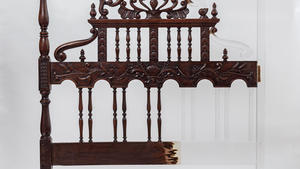This year brought a slew of international brands to the Indian design market—most notably Ikea—signifying a marked interest in the region for contemporary styles. Now, it seems like the high-end art and design market is following suit. On November 29, Sotheby’s, which opened an office in Mumbai in 2015, hosted its first-ever auction at Mumbai’s luxury Taj Mahal Palace hotel—a calculated move, especially after its competitor, Christie’s, ended four years of December auctions in Mumbai in 2017. Though Christie’s justified its stopping auctions as part of a series of global changes, many saw the move as a response to low sales in India compared with auctions in other regions. So what makes Sotheby’s different?
A major factor in the Sotheby’s strategy in India was the hiring of managing director Gaurav Bhatia in October 2017. Previously the marketing director at LVMH India, Bhatia understood that for the Indian market, exclusivity and decidedly South Asian art was key—a blueprint he used in curating the artwork for the auction, titled Boundless: India. In a recent interview with Architectural Digest India, Bhatia revealed that Indians have spent more than $248 million on South Asian art during the last five years alone. It follows, then, that Sotheby’s would be invested in capitalizing on the opportunity. (The auction house’s execution of this strategy may be complicated by Bhatia’s leave of absence since late November following a series of allegations of sexual harassment.)
According to Jan Prasens, Sotheby’s managing director for Europe, the Middle East, Russia and India, the decision to launch in India stemmed primarily from a noticeable increase of Indian collectors at international sales, as well as the emergence of a thriving domestic art market. “Given these promising signs and the projected economic growth for India in the future, it is the right time for Sotheby’s to bring our auctions directly to the doorstep of the many Indian collectors,” Prasens tells Business of Home.
 The results are a vote of confidence for the South Asian art market, with significant new records and benchmarks achieved across many different artists and genres.” —Yamini Mehta
The results are a vote of confidence for the South Asian art market, with significant new records and benchmarks achieved across many different artists and genres.” —Yamini Mehta
The shining star of last month’s auction was a never-before-seen painting by Tyeb Mehta, a prominent Indian artist known for his abstract mythological figures set across backdrops of diagonal color. The painting, called Durga Mahisasura Mardini, was commissioned from the artist in 1993 and has been part of a private collection ever since. It was the perfect headliner because it checked both the boxes—exclusivity and modernity—that have heralded success in Indian auctions, and the results delivered: The painting sold for more than $2.8 million. Other notable works included Amrita Sher-Gil’s The Little Girl in Blue (only the seventh oil painting by the artist to be sold worldwide), which fetched $2.7 million; and an untitled 1950s bronze sculpture by Sadanand Bakre (a pioneer of modern art in India and one of the founders of the Bombay Progressive Artists' Group), which sold for a record-breaking $268,000.
“The results are a vote of confidence for the South Asian art market, with significant new records and benchmarks achieved across many different artists and genres,” Yamini Mehta, Sotheby’s international head of Indian and South Asian Art, tells BOH. “Our offering included some of the most significant works to come to the market by Tyeb Mehta and Amrita Sher-Gil, two of the most beloved Indian artists of the 20th century. The sale has enabled us to connect with scores of new and existing clients, and at the same time really deepen our understanding of the market here.”
It’s interesting to note that even though Sotheby’s is an international brand, most of the works up for auction were from modern India. “I think, as Indians, we’re mostly interested in ourselves when it comes to art,” says Gayatri Rangachari Shah, a journalist and author focusing on Indian culture who attended the auction. “But I think the Sotheby’s interest was inevitable. India is reaching a level of being a global market that most international companies are interested in, but Indians are also interested in the modern masters of the art world. If you’re selling to an Indian audience, the fact that those pieces weren’t in the public space was exciting.”
 India is reaching a level of being a global market that most international companies are interested in, but Indians are also interested in the modern masters of the art world.” —Gayatri Rangachari Shah
India is reaching a level of being a global market that most international companies are interested in, but Indians are also interested in the modern masters of the art world.” —Gayatri Rangachari Shah
Contemporary styles seem to be the name of the game in the Indian art realm. Gallery openings like The Cube in Goa and the reopening of Jhaveri Contemporary in Mumbai, as well as the success of the Kochi-Muziris Biennale in Kerala, are focusing primarily on Indian contemporary art—albeit without the exclusivity that Sotheby’s touts. “One of the major trends that is hitting the space is the exploration of different mediums,” says Shah. “People—younger collectors, specifically—are more open to things like video, multimedia, drawings and video.”
For now, the Sotheby’s investment in India seems to be a promising counterweight to the divestment in the region by Christie’s. It remains to be seen whether modern Indian art will persist as the prevailing trend—or whether government policies will allow the market to expand into international territory. India’s art scene lacks international representation, a fact that Tasneem Zakaria Mehta, managing trustee of Mumbai’s Dr. Bhau Daji Lad Museum, attributes primarily to taxes rather than disinterest.
Although international retailers have come to India in droves due to a loosening of governmental regulations that make it easier to set up shop, the same has not been true of the art market: “Even collectors who collect internationally don’t bring the art to India; because they get charged so much tax, it costs double what they paid for it!” says Mehta. “In fact, when we’ve managed to get international-quality artists to India through their embassies, people have reacted really well. [But] I don’t think India can be seen as a key player in the international art market if we don’t bring in [more] international art for public consumption.”



























